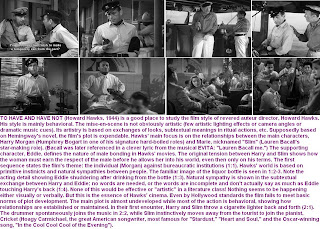NO STRINGS: TO HAVE AND HAVE NOT
THE CINEMA OF HOWARD HAWKS is difficult to illustrate because it is mainly a behavioral art. There are few shots in a Hawks film to illustrate film technique, such as a low- or high-angle shot, "artistic" lighting, etc. Hawks' cinema is mainly an invisible art of action, or even actions (gesture, expression and significant looks). In To Have and Have Not, the plot is a pretext for scenes between characters that show an already bonded relationship or the making of a new bond.Though supposedly based on Ernest Hemingway's novel, the film has little relationship to it. Hawks is more concerned with male bonding and the acceptance of a woman when she proves she shares the hero's values.
The film's subject is the conflict between the individual, Harry Morgan (Humphrey Bogart) and outside (ideological) pressures (the Nazi-established Vichy government officials and the French Resistance). This summary hardly does justice to Hawks' film, whose focus is on Morgan's relationships with Eddie (Walter Brennan) and Marie, nicknamed Slim (Lauren Bacall).
Typical of Hawks' films, several characters have nicknames (Slim, Steve, Cricket, Frenchie), which signifies their special (not formal) relationships. The nicknaming between Harry and Marie (Steve and Slim) is not that important. What matters is the ritual nature of the naming, a private understanding based on a natural and mutual sympathy.
Relationships in Hawks are instinctive, based on feeling not thinking. It may even be based on nonsense, as in the familiar image of Eddie telling the story of the dead bee. What matters is liking someone.
For example, Harry and Slim like someone or they don't. It has nothing to do with politics, which doesn't concern Harry, who prefers to mind his own business, as he says.
Nor does it have anything to do with money, unless money can be used to help people one likes. Harry likes Slim and helps a political cause for that reason. He even sides with the people in that cause, but only because he likes them.
These are themes. But where's the art?
The art is in the way Hawks shows relationships. For example, the way Harry fondly grins at the rummy, Eddie, throughout the film. The camera stays on Harry long enough to show a grin emerge on his lips as he watches Eddie, at first in seeming disapproval of him.
A useful analogy here might be a song from the musical, Fiddler on the Roof, "Do You Love Me?" The wife never answers her husband directly. She says only that she ironed his clothes, raised his children, etc.
Love here, as in Hawks, is behavioral. There are no high sentiments or big speeches. There are just ritual actions routinely performed, such as Harry pouring a bucket of water to wake up his rummy pal in the beginning of the movie.
Some of these become familiar images. Slim asks Harry for a cigarette lighter. He throws it at her. She throws it back at him. Later he just points to a drawer where the cigarettes are kept. Slim asks a stranger for a light and he follows her out the door.
Other familiar images include the passing of a wine bottle, money, or airline ticket back and forth.
There are also the many times Eddie asks for a drink. Sometimes Eddie doesn't have to ask. Harry merely says, "You can have a drink now."
In an encounter with the tourist who tried to run out without paying Harry his fee, Slim instinctively stops Harry from beating the man by getting between them. This is out of sympathy for Harry, not the man, as she says: "I don't like him either." A later shot shows the two facing the tourist in sympathy with each other and against him.
After their first exchanges, Slim starts to complete Harry's sentences, in overlapped dialogue. She has developed an understanding of how he thinks.
This sympathetic understanding extends to music. The great American songwriter, Hoagy Carmichael ("Stardust," "In the Cool Cool Cool of the Evening") has a featured role as the piano player, Cricket. Scenes are built around the sympathetic duets that emerge between Cricket and Slim.
Music involves natural sympathy. In one shot we see a drummer join band mates who have already started a song.
The final shot of the film shows Slim swaying to the rhythm of the music Cricket plays. Her spontaneous smile at Harry suggests the theme of the entire movie: the natural sympathy between individuals who trust each other.
Music plays another role in the black dancers, who suggest the primitive instincts that Hawks values above intellectualism and organized politics.
This primitive or instinctive response to life is shown in Harry's violent reaction to the knowledge that his friend, Eddie, is being held by the Vichy police. His mutual sympathy with Slim is shown in the way she leaves the drawer open to allow him to fire the gun.
The final shot of them, as she smiles at him, is something the cinema, the only behavioral art form, can do better than any other art.









No comments:
Post a Comment